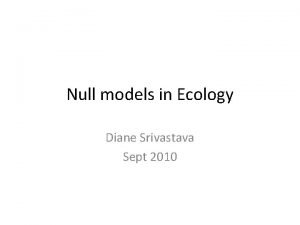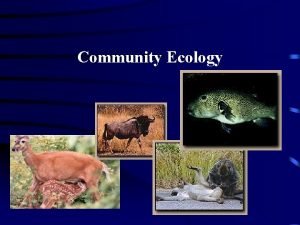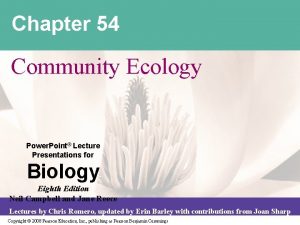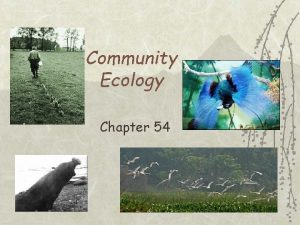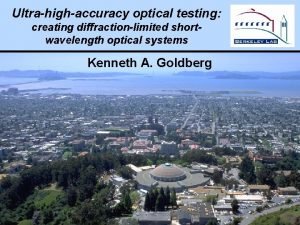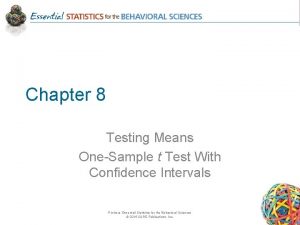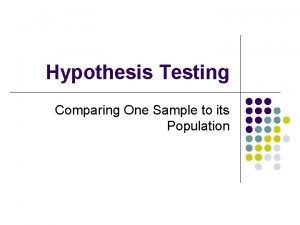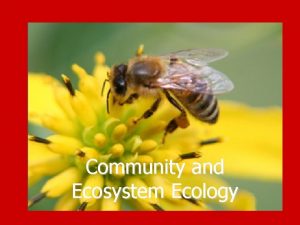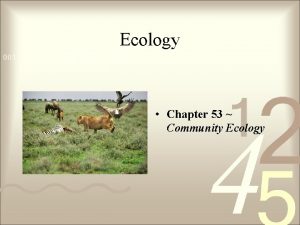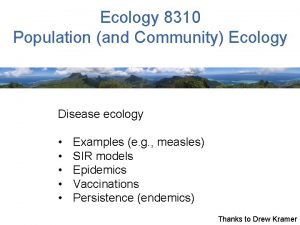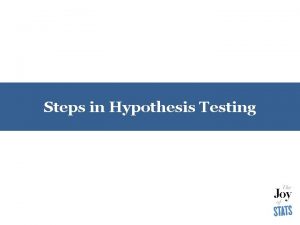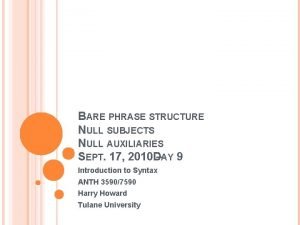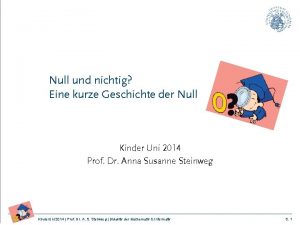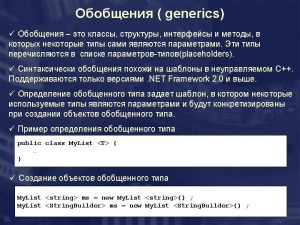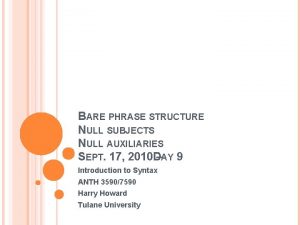Null models in community ecology Attempts to test




















- Slides: 20

Null models in community ecology Attempts to test for the mechanisms (as a counterpart to tests using the manipulative experiments)

Null models – testing for mechanisms governing assembly of communities • The basic idea – construct a model, which includes only other mechanisms than the tested one(s) [=null model] • Predict a community pattern with the null model • Compare predicted and real patterns - Pattern different from the predicted one suggests that the tested mechanism has some effect [but…. There are many mechanisms not included in the null model]

Classical example – “variance deficit” • One matrix only is available – species x samples • Null model – the species are assembeld completely randomly (but there must be some constraints – in this case, usually the frequency of the species is kept constant) • Pattern (the criterion) – variance of the number of species in individual samples

The hypothesis • If there is a mechanisms limiting number of niches at a site, then the number of species should be less variable than without this mechanism • If there are positive relationships between species, then presence of one species will increase the probability of presence of another species, and thus, the variability (variance) in species number should be high

spec 1 spec 2 spec 3 spec 4 nsp Sample 1 0 1 2 Sample 2 1 1 0 1 3 Sample 3 1 1 4 Sample 4 0 1 0 0 1 Sample 5 1 0 0 0 1 Sample 6 0 0 1 1 2 Sample 7 1 0 2 Sample 8 0 1 2 Sample 9 1 0 0 1 2 Sample 10 0 1 1 0 2 spec freq 5 6 4 6 0. 766667 Var nsp

Basic idea if no. of species is limited by no. of niches, then var is low high nsp variance no. of species Sample 1 Sample 2 Sample 3 Sample 4 Sample 5 Sample 6 Sample 7 Sample 8 Sample 9 Sample 10 variance 10 9 1 2 1 8 6 0 1 11 18. 76666667 low nsp variance no. of species 5 5 4 6 5 5 4 5 5 6 0. 44444

Compared against the “null model” spec 1 spec 2 spec 3 spec 4 nsp Sample 1 0 1 2 Sample 2 1 1 0 1 3 Sample 3 1 1 4 Sample 4 0 1 0 0 1 Sample 5 1 0 0 0 1 Sample 6 0 0 1 1 2 Sample 7 1 0 2 Sample 8 0 1 2 Sample 9 Sample 1 0 0 1 2 0 1 1 0 2 spec freq 5 6 4 6 New var Any species can be anywhere, the species frequencies are kept constant – (in this null model)

Null model generated many times (e. g. 1000 time) • I will get – average of criterion (variance in nsp) here - expected value • Quantiles – 25 th value and 975 th value provide 95% envelope • The real value is compared with the average (is it higher or lower than expected under the null model) and with quantiles (statistical test of the null model) • Standardized effect size SES =(observed – expected)/s. d. (expected)

Similarity to classical hypothesis testing P for one-sided test

Null model generated many times (e. g. 1000 time) • I will get – average of criterion (variance in nsp) here expected value • Quantiles – 25 th value and 975 th value provide 95% envelope • The real value is compared with the average (is it higher or lower than expected under the null model) and with quantiles (statistical test of the null model) • Standardized effect size SES =(observed – expected)/s. d. (expected) I think that SES is dependent on the size of the matrix, and thus is not a good measure of the effect – just to discuss

Variance excess/deficit • Can be explained by many possible biological mechanisms • Variance excess (SES>0) – environmental heterogeneity, positive species relationships • Variance deficit – competition/“niche limitation“ • But there is still question, which mechanisms ARE still reflected in the null model (low frequency of some species is very probably result of competition)

Traits available • Renewed interest in the „assembly rules“ • Are there any rules, determining which species are able to coexist? (Classical zoologist idea, e. g. J. Diamond and his birds) • Two matrices available (species x samples, species x traits) – various null models can be generated


What can be tested? • Limiting similarity concept – niche differentiation enables species coexistence trait divergence coexiting species are less similar than expected by chance (but is trait differentiation really the same as niche differentiation? ) • Environmental filtering – causes the trait convergence • „Scale dependence“ of results (divergence at smaller spatial scales)

• If locally coexisting species are more similar to each other than expected by chance (trait convergence due to environmental filtering), then functional beta diversity is higher than expected • If locally coexisting species are less similar to each other than expected by chance (limiting similarity -> trait divergence), then functional beta diversity is lower than expected • What is expected use the null models

With two matrices, you have plethora of randomization possibilities • E. g. , compositional table is fixed, and the traits are randomly assigned to individual species. • However, the traits are usually also determinants of species frequency, and this dependence is interupted. • So, it is always a problem, which relationships are included, and which excluded from the null model

If the trait – frequency relationship is interupted • In a meadow, species with „subordinate“ traits might be the most frequent species (it is possible in reality, but usually not likely) • The differences between the null communities and the real communities might be cause solely by this effect (I am not sure how likely it is)

Other possibility • Keep the species – trait matrix fixed, and shuffle the species in the compositional matrix (as in the example for the variance deficit) • Or, various swaping algorithms, that try to keep both the numbers of species and species frequncies constant

Randomization in our project • Two scales – needles within a quadrat • Quadrats within a plot • For individual needles, calculate FD on the basis of presence – Rao? For each trait separately? • What to calculate for the Phylogen Diversity? • For quadrats – Rao based on cover. • Randomization – randomize trait among species - for needles, only species within a quadrat

Direct test whether species similarity (in traits) is correlated with their „interspecific associations“ – using the Mantel test
 Null models in ecology
Null models in ecology Is india near the equator
Is india near the equator Ecosystem vs community
Ecosystem vs community Community ecology
Community ecology Study guide chapter 3 section 1 community ecology
Study guide chapter 3 section 1 community ecology Chapter 54 community ecology
Chapter 54 community ecology 5 evolution and community ecology
5 evolution and community ecology Definition of community ecology
Definition of community ecology More diverse
More diverse Chapter 5 evolution and community ecology
Chapter 5 evolution and community ecology Chapter 5 evolution and community ecology
Chapter 5 evolution and community ecology Community definition ecology
Community definition ecology Community ecology
Community ecology Ecology part 1
Ecology part 1 Chapter 54 community ecology
Chapter 54 community ecology Diffractive null test
Diffractive null test One sample test statistic
One sample test statistic Statistical hypothesis formula
Statistical hypothesis formula What is the difference between model and semi modal
What is the difference between model and semi modal Honors biology ecology test
Honors biology ecology test Chapter 4 section 1 population dynamics
Chapter 4 section 1 population dynamics
